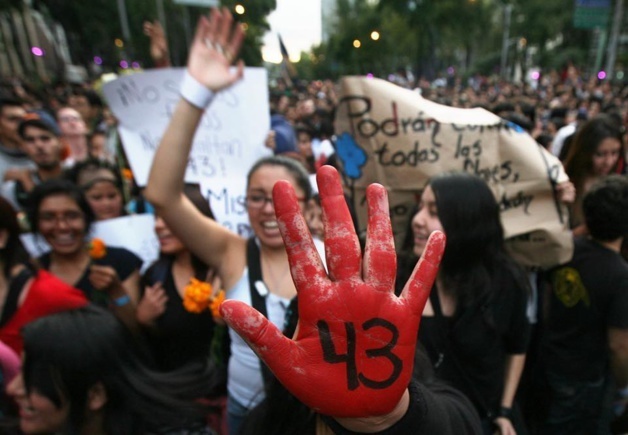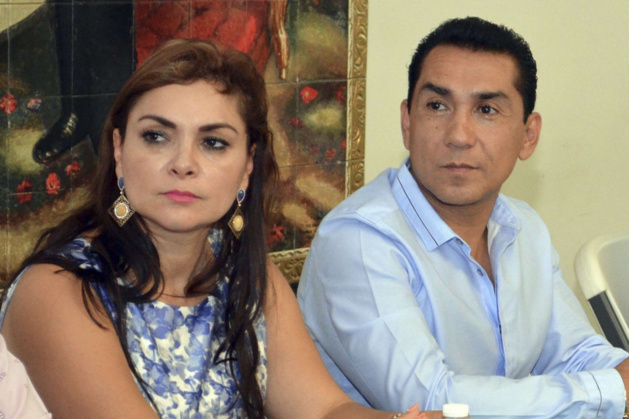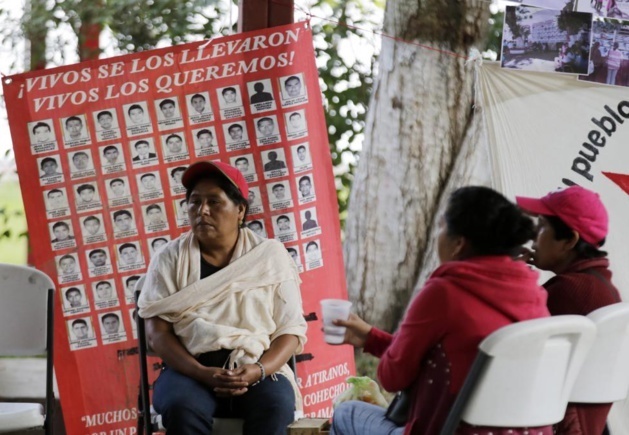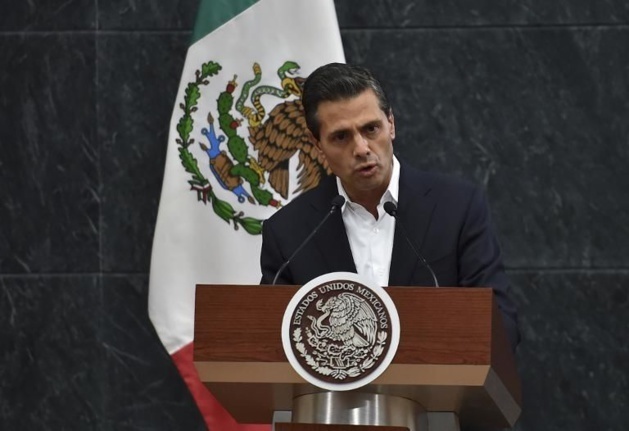
Crédit Marco Ugarte / AP
On 26th September, 57 students from the Ayotzinapa Normal School, aged 18 to 21, went to Iguala to launch a fundraiser and organise an important demonstration in the near future. As they were about to leave Iguala, they were attacked by the local police and members of the Guerreros Unidos cartel in a shootout that resulted in six killed and about twenty-five injured. The survivors were then taken away in police cars and have been missing since then. According to many witness statements, the police gave the students to one of the local drug cartels, Guerreros Unidos, after the gunfire.
The Iguala tragedy and the “imperial couple”
Ten days after the events, local authorities found 28 charred bodies in an illegal mass grave near Iguala. However, the Mexican police announced on 11th November that no trace of the 43 students’ DNA had been found in the grave.
The case was reopened on 7th November, the same day Secretary of State for Justice, Jesús Murillo Karam, announced the confessions of three members of Guerreros Unidos, arrested after the events. According to their statements, the bodies of the 43 missing students were burnt on a gigantic bonfire for almost 14 hours and their remains thrown in the nearby San Juan river.

Since the end of September, over 70 Guerreros Unidos members and local administrators have been arrested. On 4th November, the Mexican federal authorities arrested, among others, the “imperial couple”, José Luis Abarca and his wife Maria de los Ángeles Pineda, who had fled to the capital city two days after the events.
José Luis Abarca, mayor of Iguala, is indeed reportedly involved in this tragedy, having personally ordered the attack on the Ayotzinapa students by the local police. Today, he is accused of being the orchestrator of these crimes in association with the local drug dealers, while his wife, Maria de los Ángeles Pineda, is reported to be the sister of three Guerreros Unidos traffickers.
The Mexican civil insurrection: “one case too many” according to Abel Barrera
According to Abel Barrera, founder of the Tlachinollan Centre for Human Rights of the Montaña, the Iguala tragedy is “one case too many for the people, who are indignant at the government’s inability to find the missing people”.
Since the disappearance of the 43 students, demonstrations in the heart of Guerrero have been multiplying. The victims’ families as well as the Mexican population are showing their refusal to accept the official version of the Mexican government without genuine proof and are still demanding that the missing students be given back to them alive.
Since the disappearance of the 43 students, demonstrations in the heart of Guerrero have been multiplying. The victims’ families as well as the Mexican population are showing their refusal to accept the official version of the Mexican government without genuine proof and are still demanding that the missing students be given back to them alive.

On 10th November, for instance, protestors blocked access for several hours to the international Acapulco airport and set fire to the government party headquarters (the IRP), in Chilpancingo the following day. On 12th November, around 500 pupils and teachers also partially set fire to the Guerrero Parliament.
Since Thursday, the families of the missing people have started a tour in the state of Guerrero in order to emphasise the pressure on the federal authorities, so that they carry on their search and find the 43 missing students. They have already planned to go to Mexico on 20th November, National Day of the Mexican Revolution, to continue asking for justice to be done.
Since mid-October, the demonstrations seem to have acquired an international stature, as shown by the numerous gatherings of people all over the globe, in particular in Paris in an outpouring of support for the victims’ families. According to Mauricio Mejia, a Mexican student in his 4th year at SciencePo, who participated in the demonstrations in Paris, it is “very important to express one’s opinion outside Mexico for the international community to be aware of what is really going on. It is necessary to part with the official internationally-given speech, according to which Mexico is in the middle of a changing process and modernisation thanks to the economic reforms and violence is a collateral issue which is almost under control”.
Severe consequences for the Mexican political class
After the resignation on 23rd October of the State Governor of Guerrero, Ángel Aguirre, and that of the State Attorney General, Iñaky Blanco on 12th November, a large proportion of the population is today demanding the resignation of the Mexican president, Enrique Peña Nieto.
While he was idolised by the international press and notably described on the Times’ front page as the “saviour of Mexico” in February 2014, Enrique Peña Nieto is currently experiencing the most severe crisis of his presidency since his rise to power in 2012.
While he was idolised by the international press and notably described on the Times’ front page as the “saviour of Mexico” in February 2014, Enrique Peña Nieto is currently experiencing the most severe crisis of his presidency since his rise to power in 2012.

In this way, the Iguala tragedy highlights unfortunately one of Mexico’s deepest plagues at the moment: corruption of the political and police authorities with local drug cartels.
According to Mauricio Mejia, “the Mexican government is twice responsible. Iguala’s local government ordered the students’ disappearance and their management by the Guerreros Unidos cartel. But the federal government is also responsible by its late and inefficient action and by the lack of information communicated to the families. We’ve come to realise that the coalition between the government and drug traffic is real and dangerous”. He adds “the possible resignation of Peña Nieto must not be justified “only” by the students’ disappearance but by the 20, 000 people reported missing during his term and the absence of a rule of law in Mexico”.
According to Mauricio Mejia, “the Mexican government is twice responsible. Iguala’s local government ordered the students’ disappearance and their management by the Guerreros Unidos cartel. But the federal government is also responsible by its late and inefficient action and by the lack of information communicated to the families. We’ve come to realise that the coalition between the government and drug traffic is real and dangerous”. He adds “the possible resignation of Peña Nieto must not be justified “only” by the students’ disappearance but by the 20, 000 people reported missing during his term and the absence of a rule of law in Mexico”.
The Iguala case will undoubtedly leave a deep mark on Enrique Peña Nieto’s presidency. The question that remains now is whether it will allow the launch of a revival of the Mexican political class as well as an efficient fight against corruption and the control drug cartels have on Mexican soil.































